


Edward Partleton (b C1711)
How many people across the world are there currently alive who were born with the surname Partleton?... well, not very many. At the time of writing (2008) there are 192, according to my family tree software, which should be fairly close to the mark... and I'm not even one of them.
All of these 192 people are descended from just two men. One of them, who lived in Cumberland in the north-west of England in the early 1700s, is Edward Partleton, the subject of this page. In fact he's the oldest record we have so far:

Above we see Edward's marriage to Catharine Jobson in 1730; information from the website of the Church of Jesus Christ of Latter-day Saints (the LDS).
We also find more information about this same marriage in a book published in 1927 'Marriage Bonds for the Deaneries of Lonsdale, Kendal, Furness and Copeland'

The witnesses named in the above clipping, which Google Books insists on truncating, are 'Anthy. Davies and Frn. Yates', but I believe they are church officials as they are named as witnesses to more than one marriage.
The wedding took place in Whitehaven, Cumberland:

Whitehaven was a mining town and was very successful for shipping until the rise of Liverpool and Bristol. Below we see a nice early map which shows Whitehaven harbour:
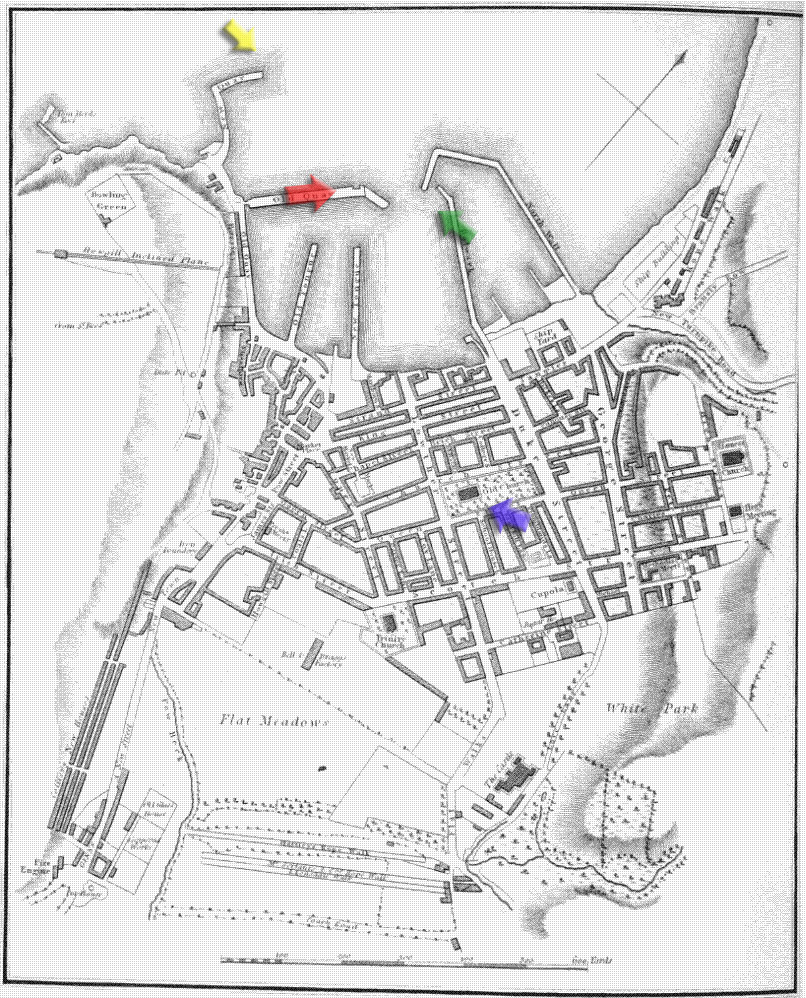
So let's have a look at the church in which Edward was married; St Nicholas Whitehaven. Here it is on 31 August 1971, from the viewpoint of the blue arrow in the map:

Oh dear. The church which we see going up in flames is a Victorian (1883) rebuild of the church in which Edward was wed (which was built in 1693). The tower survived the fire, but it may be part of the Victorian rebuild in any case; I'm not sure Edward would recognise what remains:
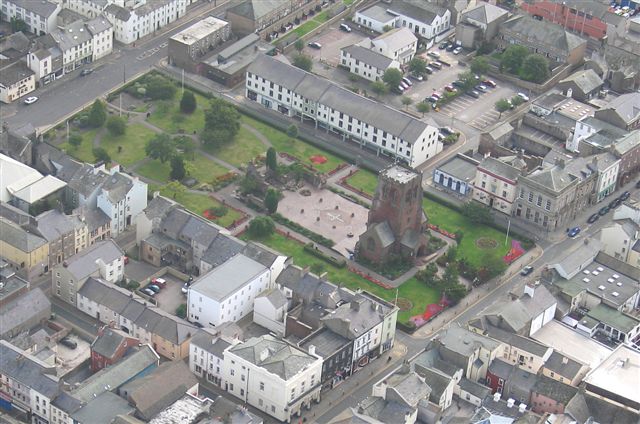
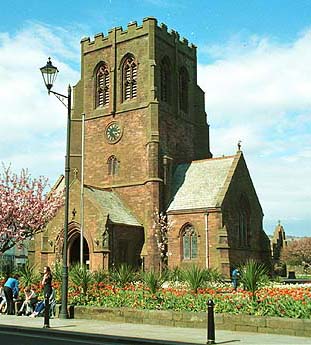
George Washington's grandmother (died 1700) is buried in the graveyard of St Nicholas Whitehaven.
Living just a mile north of Whitehaven, Edward could hardly be unaware of its shipping tradition. The harbour could hold 100 ships, as we see below:

The above picture of the harbour mouth on a lovely still day is seen from the viewpoint of the yellow arrow in the map below:

Below, on a stormy day, we see the harbour from the viewpoint of the green arrow in the map, as painted by the notable marine artist Robert Salmon:
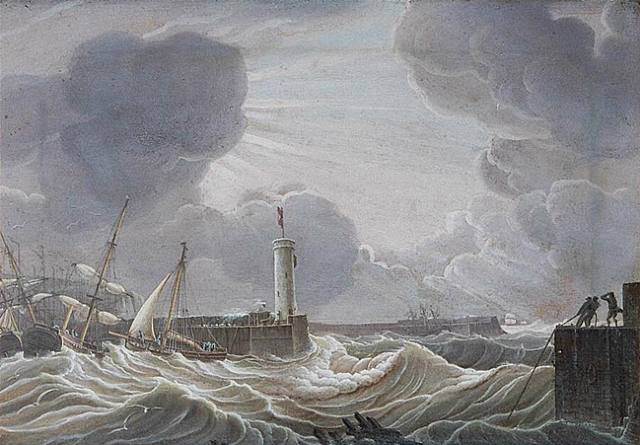
Finally, let's step into Edward's shoes in 1730 and take a stroll along the Old Quay where we will see the harbour entrance from the point of view of the red arrow:

In August 1729, a boy is born:
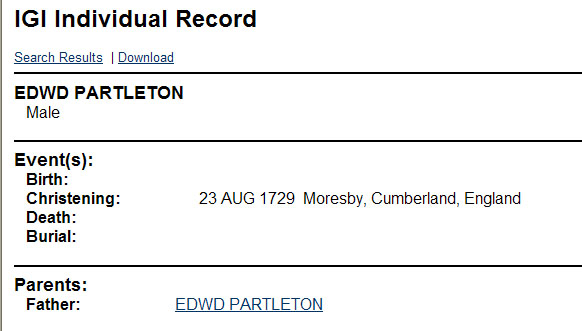
Some of you with good memories may have spotted that this birth occurs a year before the marriage, which took place in December 1730... frankly, I don't have a good explanation for this, except that we have already come across dozens of illegitimate children and shotgun weddings.
We see in the christening record that the baby is baptised at Moresby, which is next to the Village of Parton which you may remember was mentioned in the marriage record:

So, we know that Edward Partleton was living in Parton... just a minute... our first-known Partleton lived in Parton... any connection here? I think probably not, but I couldn't let it pass without comment.
It's high time we had a closer look at Parton. The first thing is to get our bearings. Exactly where is Parton?:
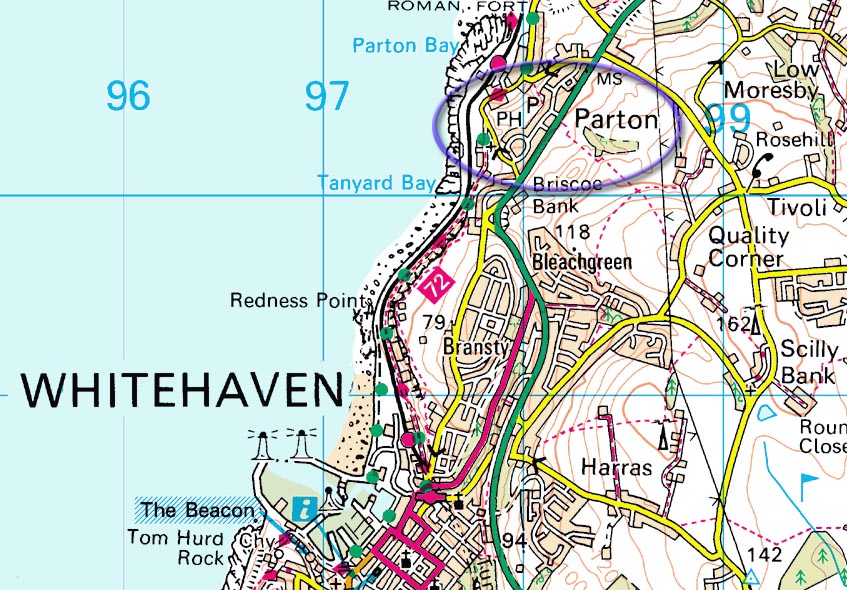
The detailed map below is very similar to one of 1867. It's the best I can do, but we should treat it with caution. Clearly there was no railway in 1730, though the main thoroughfares of Main Street and Foundry Road which snake through the ribbon of cottages which form the village would be familiar to Edward.

Here's a modern view [2009] of Parton, courtesy of Wikipedia, seen from the red arrow in the map above, looking towards St Bridget's church in the distance, circled in blue in the map:

I reckon virtually all the houses in this photograph are post-1730, but the topography of this bay and the surrounding hills, and the overall village ambience would be absolutely recognisable to Edward, so let's step into his shoes, let the sea breeze blow through our hair, and admire the view for a moment.
I have resisted the urge to use Victorian photos of Parton, because they are more than 100 years too late for our Edward, but this one was too good to resist; the railway dominating the village, cutting the inhabitants off from the sea, seen from the green arrow in the map:
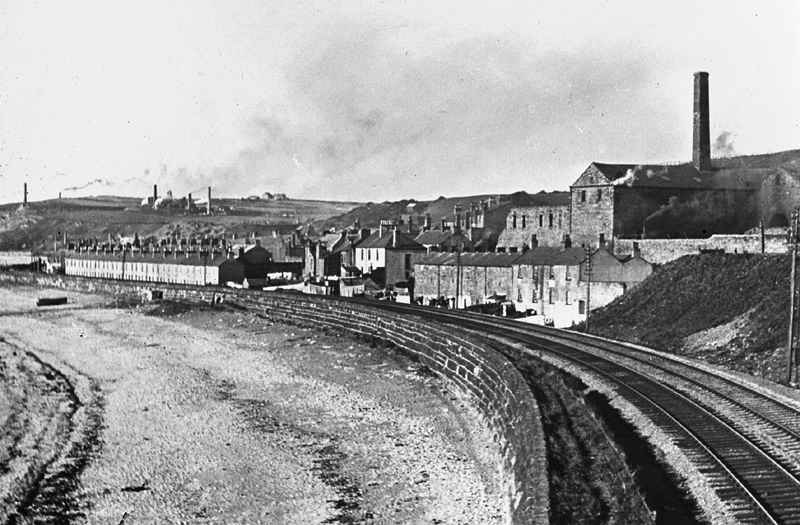

Sooooo... Edward Partleton, the first Partleton whom we find anywhere in any record in the world - settled down and married in Parton, Cumberland... but why?
Parton was a small port, but more importantly, in common with much of the area around Whitehaven, it was a coal mining area - we can see a couple of pits named in the old map above. Almost all of Edward's descendants were involved in the mining industry - coal miners, iron ore miners, foundry workers, in wide ranging-roles from humble colliers to machine operators to engineers, so I think it's reasonable to assume that Edward is involved in coal mining in Parton.
One year after his marriage, Edward fathers a second child, Mary Partleton, in 1731:

Both of these christenings take place at the church at Moresby which is a mile or so north of Whitehaven, near to Howgate Colliery:
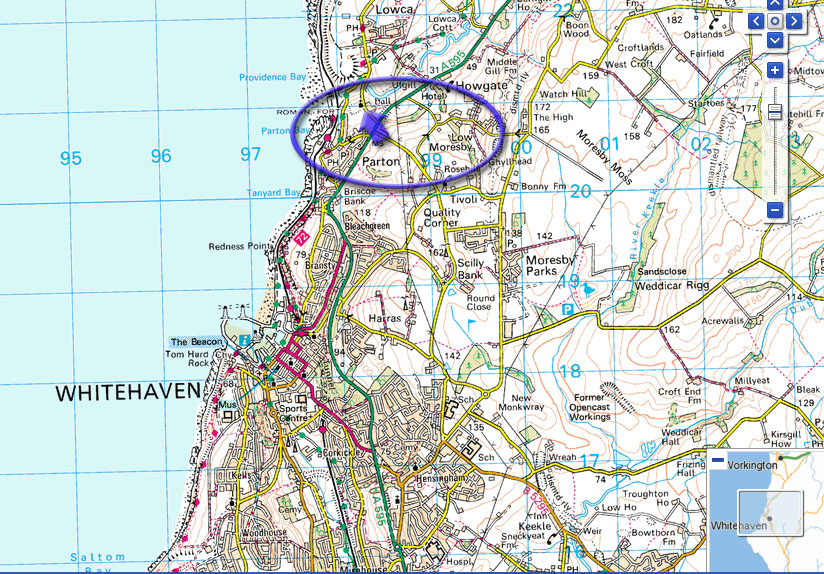
The church at Moresby is St Bridget's, founded in an attractive rural setting looking out to sea:
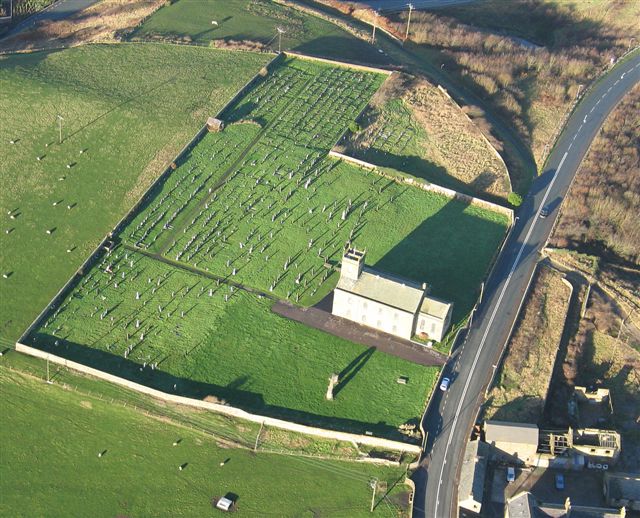
Before we get too excited about this church, we learn that it was built in 1822, so it's not the same building in which Edward had his babies christened...
But there were churches on the site before 1822, as witnessed by this arch; a relic of a medieval church in St Bridget's churchyard, which can be seen in the foreground of the aerial shot above, and in the photograph below. I guess this was probably an ancient relic even when Edward was christening his kids. He'd have seen it in 1730:
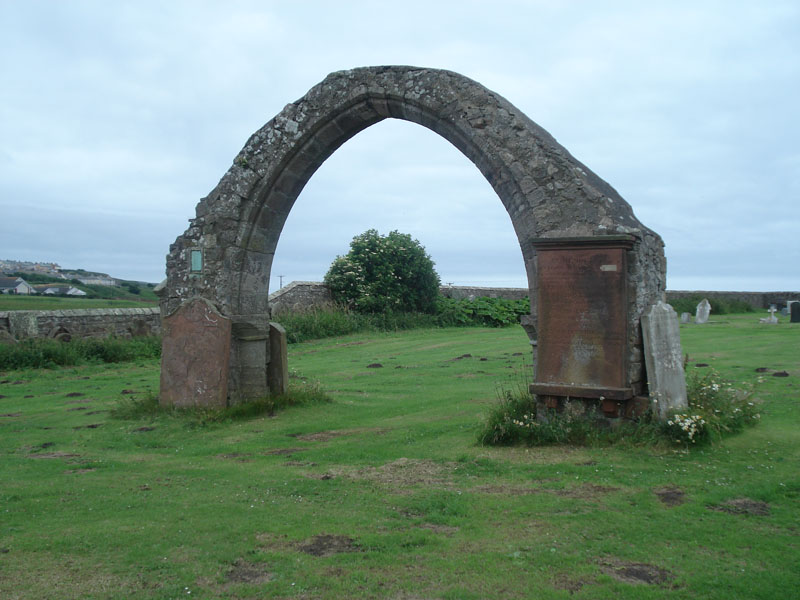
To witness what a stunning setting St Bridget's has, the best view is from the purple arrow in the map, as we see it below, with Whitehaven harbour in the background:


And if we look northward toward the church from the viewpoint of the blue arrow, we see Moresby Hall in the foreground:

The frontage of Moresby Hall was remodelled by famed architect Inigo Jones in 1617 and further remodelled by Thackeray or Addison in 1670-1690:

The building would be a very familiar sight to our Edward, as it is unchanged since 1690. He and his family would have passed it on the road on their way to church, as we see in the photo below:
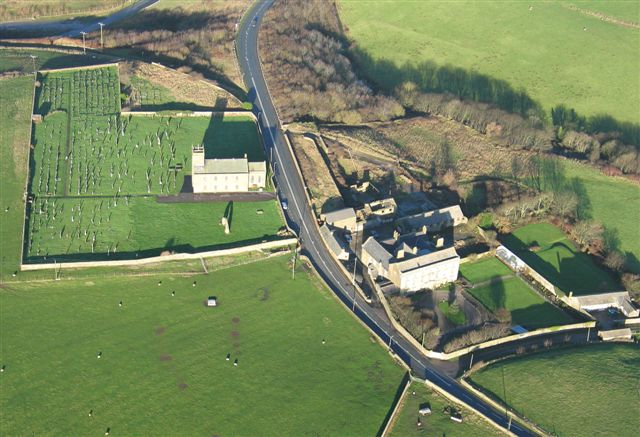
Edward Partleton and Catherine Jobson probably had at least two further children, as we shall see in a moment, but the records are sketchy and tantalising at this date, so this is a perfect moment to return to our original claim that all Partletons are descended from just two men. Here's the immediate family of Edward, in Cumberland:

And on the other side of the country, in London, we find Thomas Partleton:

What is the connection between these two men? Is it possible that they are related? Or to put it another way, is it possible that they are unrelated?
Thomas Partleton was married in 1759 in the parish of St James Westminster to Hannah Dunsdon. Searching back through the parish registers for St James, we find the birth of Hannah Dunsdon on 30 September 1736,

but Thomas can't be found in this baptism register. Terry Partleton has scoured the St James Parish register, and the evidence is that Thomas wasn't born in the parish. In fact we don't know when or where he was born. But let's assume that he's about the same age as his wife, or a little older, as is often the case, which puts his birth date at 1732 to 1736.
So... looking at the above two family trees, could Thomas Partleton in London be the son of Edward Partleton in Cumberland?... He's about the same age as Edward's two known children, Edward and Mary...
The answer is that we don't know, and this is too big a leap to make without any actual evidence. Just to illustrate that this bit of the research is tricksy, here are two other christenings, of perfect dates, in Cumberland, right place, right time, both of whom are very probably children of our Edward:

You'll have to take my word for it, there's no such name as Partinton. Camerton is a few miles north of Whitehaven, past Workington, but in 1736, as we see below, Edward "Partinton" is back in Whitehaven. You can make your own mind up, but I certainly believe this is our Edward.

Literacy was not high at this date, and spellings were not formalised. We are going to have to be really smart to work our way back from here.
For much of this early information, we rely on the online database of the Church of Jesus Christ of Latter-Day Saints (aka LDS). Here's how, earlier, from the LDS website, we saw the christening record of Edward's son, Edward jr:

And when we search the Parish Registers for young Edward's marriage, we find it in 1752:


But when we search the LDS, we find something quirky... an extra variation of the name:

Clearly the original record says Edward Partleton, but the LDS researcher who was assigned to the task of unpicking the 'pedigree' has recognised from later records that the names Partleton and Partington tend to become rather tangled in Cumberland, so she hedges her bets to assist genealogists and provides both variants.
The only way to get to the root of this is to examine the actual parish registers. Copies of these are held at the Cumbria Record Office in Whitehaven. So here's a request... anyone living in Cumbria? Any chance you might leg it down to Scotch Street and take a look, and preferably get a copy of the original records?:
Cumbria Record Office and Local
Studies Library, Whitehaven
Scotch Street
Whitehaven
CA28 7NL
Tel:01946 852920
Let's get back to the subject of this web page; Edward Sr. So far we have established that he was married at St Nicholas Whitehaven in 1730, which would typically place his birth date at circa 1710. There's nothing in the LDS database for any Partleton before 1729, but look what happens when we search for the birth of Edward Partington:

This appears to be the birth of Edward Partington in 1711 at St Nicholas Whitehaven. Perfect. One of only six Edward Partingtons born in the whole of England between 1701 and 1721, and at exactly the right church in Whitehaven. HOWEVER... I'm fairly sure the LDS have merely done the exact same thing we just did, and projected a likely birth date based on Edward's marriage of 1730 in Whitehaven. The LDS want to baptise Edward posthumously in order that he will go to heaven - indeed they have already done it - that's why they collect all these names ... But if the LDS created the record this way, why did they use the name Partington, not Partleton which was in the marriage register?
My belief at present is that if we are going to search back for Partletons into the 1600s, we are actually going to be looking for Partingtons.
As I said, we need to see those original records.
If you enjoyed reading this page, you are invited to 'Like' us on Facebook. Or click on the Twitter button and follow us, and we'll let you know whenever a new page is added to the Partleton Tree:
Do YOU know any more to add to this web page?... why not send us an email to partleton@yahoo.co.uk
Click here to return to the Partleton Tree 'In Their Shoes' Page for Cumberland